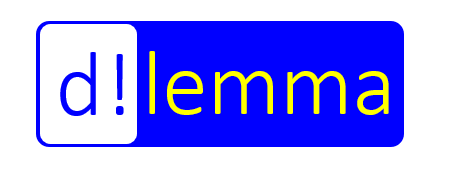EBTCs
Empresas de base tecnológica URJC

En julio de 2017, profesores e investigadores de la Universidad Rey Juan Carlos pusieron en marcha DESILICO. Una empresa del tipo spin off orientada al sector textil que desarrolla herramientas de simulación y visualización 3D.
Participada por la URJC: SI

En 2022 se creó, junto a la UMH, la EBT DILEMMA LAB, dedicada fundamentalmente a desarrollar servicios y productos basados en algoritmia inteligente y ciencia de datos
Participada por la URJC: SI
Master universitario en Periodismo Digital y Nuevos Perfiles Profesionales
Centro responsable: Escuela Másteres Oficiales Lugar: sede Madrid-Quintana
Modalidad: Presencial Código del título: 6295 Plan nuevo 6398 Orientación: Profesional
Nº de Créditos ECTS: 60 ECTS Duración del Máster: Un curso académico
Precios públicos: Ver tabla
Calendario académico Horario Exámenes Guías Docentes Profesorado
Codirector Académico: D. José María García de Madariaga Miranda. Codirectora Técnica: Dª. María Eugenia Lozano López. Teléfono: 91 488 7258
Correo electrónico:
Información master universitario: Teléfono: 91 665 5060 Buzón de Consultas
Atención al estudiante: Buzón de Ayuda al Estudiante Buzón de sugerencias, quejas y felicitaciones
Master universitario en Prácticas Artísticas Contemporáneas
Centro responsable: Facultad de Artes y Humanidades Lugar: Aranjuez
Modalidad: Presencial Código del título: 6344 Orientación: Profesional
Nº de Créditos ECTS: 60 ECTS Duración del Máster: Un curso académico
Precios públicos: Ver tabla
Calendario académico Horario Exámenes Guías Docentes Profesorado
Director del Máster: D. Vicente Alemany Sánchez- Moscoso
Correo electrónico:
Información master universitario: Teléfono: 91 665 5060 Buzón de Consultas
Web del máster
Atención al estudiante: Buzón de Ayuda al Estudiante Buzón de sugerencias, quejas y felicitaciones
Master universitario en Periodismo Internacional
Centro responsable: Escuela Másteres Oficiales Lugar: sede Madrid-Quintana
Modalidad: Presencial Código del título: 6294 Plan nuevo 6407 Orientación: Profesional
Nº de Créditos ECTS: 60 ECTS Duración del Máster: Un curso académico
Precios públicos: Ver tabla
Calendario académico Horario Exámenes Guías Docentes Profesorado
Directora: Dña. Sonia Valle de Frutos. Teléfono: 91488 7510
Correo electrónico:
Información master universitario: Teléfono: 91 665 5060 Buzón de Consultas
Atención al estudiante: Buzón de Ayuda al Estudiante Buzón de sugerencias, quejas y felicitaciones
Cesar Valiente Gordo
Ingeniería Técnica Informática de Sistemas, Móstoles 2007.
Máster Oficial en Sistemas Telemáticos e Informáticos, Móstoles 2010.
Máster Universitario en Software Libre, Fuenlabrada 2012.
- Líder Técnico en Microsoft (equipo de OneNote), Berlín, Alemania.
César es actualmente Líder Técnico en Microsoft en Berlín (Alemania) en el equipo de OneNote. Aplicación basada en notas, esencial para Microsoft dentro del sector de productividad/educación.
Entre sus tareas destacan las de diseñar e implementar el nuevo motor de creación de notas de Microsoft, así como de coordinar el equipo encargado de la aplicación de Android para OneNote en su integración con el nuevo motor.
Su trayectoria ha ido en continuo crecimiento, incluso antes de acceder a la universidad, pasando por puestos de reparación y puesta a punto de equipos informáticos, hasta programador en la división de logística de ECI; y ya durante sus estudios universitarios, obtuvo diversas becas en grandes empresas del sector de la consultoría.
Coincidiendo con sus estudios de Máster en Sistemas Telemáticos e Informáticos, estuvo durante más de 3 años en una pequeña startup madrileña donde desarrollaron un sistema de visionado de video con tecnología P2P.
A César siempre le han motivado los retos y seguir creciendo como profesional. Por eso después de su paso por la startup decidió en 2011 irse a vivir a Ámsterdam (Holanda), donde cambió su rol de programador backend por programador móvil, en un momento en que dicho mercado estaba empezando. Allí trabajó en una de las agencias móvil más destacadas de Holanda, compaginándolo con sus estudios de último curso del Máster en Software Libre.
Un año después pensó que le motivaba más trabajar en productos propios que en productos para terceros, por lo que se mudó a Berlín donde se unió a la startup que por aquel entonces estaba empezando a desarrollar una aplicación de tareas, -Wunderlist-, que luego pasó a ser una de las mejores aplicaciones de tareas del mundo, siendo adquirida por Microsoft.
Ya formando parte de Microsoft, fue parte esencial del equipo que empezó Microsoft To-do, pasando después al puesto que desempeña actualmente dentro del equipo de OneNote.
Consciente de que el sector del software es muy dinámico, César trata de mantenerse actualizado compaginando su trabajo en Microsoft con labores de colaboración con la comunidad de software. Siendo también desarrollador de software libre y habiendo participado en multitud de conferencias nacionales e internacionales del sector móvil.
Queremos destacar de nuestro compañero que ha sido galardonado por parte de Google con la mención de Google Developer Expert en Android. Mención otorgada a aquellos profesionales que de forma altruista ayudan al desarrollo de la comunidad de software en productos basados en sus tecnologías. Y que en su tiempo libre enseña a refugiados de guerra y gente desfavorecida en Berlín programación en Android, con la esperanza de que puedan tener un futuro mejor.
Para César la URJC, “su uni”, siempre será un lugar especial, en el que aprendió a pensar de forma diferente, a afrontar problemas, a escuchar alternativas, a trabajar solo y en equipo, etc. Pero también el lugar en el que empezó a disfrutar de su trabajo y en donde descubrió que lo que se hace con pasión, trabajo y esfuerzo siempre llega a buen puerto.
Reconoce que gracias a la calidad y pasión de sus profesores, también aprendió que en este sector de la tecnología siempre se debe estar en continuo aprendizaje y que no basta con tener un título.
"Siempre se debe estar atento y dispuesto al cambio, listo para afrontar nuevos retos y decidido a seguir creciendo”.
Master universitario en Ciencias Actuariales y Financieras
Centro responsable: Escuela Másteres Oficiales Lugar: Campus Madrid - Quintana
Modalidad: Presencial Código del título: 6290 Orientación: Profesional
Nº de Créditos ECTS: 120 ECTS Duración del Máster: Dos cursos académicos
Precios públicos: Ver tabla
Calendario académico Horario Exámenes Guías Docentes Profesorado Profesorado externo
Directora del Máster: Prof.ª Dr.ª D.ª Sonia de Paz Cobo. Teléfono: 91488 8028
Correo electrónico:
Información master universitario: Teléfono: 91 665 5060 Buzón de Consultas
Atención al estudiante: Buzón de Ayuda al Estudiante Buzón de sugerencias, quejas y felicitaciones
La ETSII pone en marcha un curso de programación competitiva
La actividad va destinada a mejorar las habilidades como programadores de nuestros alumnos y se celebrará del 26 de enero al 23 de marzo en el campus de Móstoles.
Good results in the elimination of drugs and stimulants in waste waters using green filters
The data obtained show the excellent performance of these water treatment systems using plants as filtration agents. The new results make clear that they constitute a suitable system to eliminate, in the great majority of cases, the so called emerging contaminants such as drugs (analgesics, anti-inflammatory drugs, etc.) or stimulants (caffeine). In comparison with conventional water treatment systems, the percentages of elimination of these substances were in many cases greater. The study was carried out by researchers from URJC, in collaboration with the IMDEA Institute for Water and the Centre for New Water Technologies (CENTA).
Sala de prensa
Contenidos disponibles en línea
Diego Pardo Fernández
Graduado en Periodismo y Graduado en Economía Madrid-Vicálvaro, 2017.
- Asistente de prensa en la Dirección General de Formación Profesional con una beca formativa especializada en áreas y materias educativas del Ministerio de Educación, Cultura y Deporte.
Diego lleva a cabo tareas relativas a la comunicación, la promoción y el análisis del estado de la Formación Profesional (FP), en España. Principalmente se encarga de dar a conocer los ciclos de las 26 familias profesionales que componen la FP en España. En estas enseñanzas están matriculados unos 800.000 alumnos y junto con los integrantes de su equipo, Diego está decidido a luchar contra el estigma que existe en torno a la FP, a través del portal TodoFP http://todofp.es/inicio.html defendiendo que la Formación Profesional es igual de digna que cualquier otra modalidad de enseñanza del sistema educativo español.
En esta línea de trabajo, se siente orgulloso de ser el encargado de promocionar ofertas de empleo público para técnicos de FP, convocadas por cualquier Administración Pública. Y a pesar de que el proyecto está todavía en fase de implantación, en los últimos dos meses y medio ha gestionado cerca de 10.000 plazas correspondientes a diversos perfiles profesionales: policías, bomberos, militares, cocineros, técnicos de laboratorio, técnicos en cuidados auxiliares de enfermería, administrativos, etc.
Recientemente, ha elaborado un documento de asesoramiento sobre la financiación del sistema sanitario para la Junta de Extremadura, a través de la Fundación Alternativas. El proyecto surgió tras la defensa de su TFG sobre el Estado del Bienestar y le ha permitido colaborar con notables expertos nacionales en la materia, a destacar el catedrático de Economía Aplicada de la URJC, Jesús Ruiz-Huerta Carbonell, o el ex secretario de Estado de la Seguridad Social, Octavio Granado.
También ha sido redactor en la sección de Economía de la Agencia EFE durante un año, gracias a una beca de Bankia. Anteriormente, estuvo en La Voz de Galicia, donde comenta que descubrió los entresijos del periodismo local y aprendió a valorar el trabajo de campo que se hace en estas redacciones para dar a conocer los temas cotidianos, pero de gran interés para los lectores locales. Sin olvidar la que fue su primera experiencia laboral en la Dirección General de Comunicación del Parlamento Europeo, en la Oficina de Información para España. Ya que para él fue “sensacional” trabajar en un ambiente internacional, con equipos dinámicos y en permanente relación con el corazón de Europa.
De su paso por la universidad, destaca los beneficios de haber podido estudiar dos grados simultáneamente: Periodismo y Economía. Una combinación que dice ha sido muy bien valorada en los entornos profesionales en los que ha trabajado y/o colaborado. Por ello valora especialmente el hecho de que la URJC sea una de las universidades españolas con más dobles grados en su oferta académica. Por último, comenta que la universidad le ha permitido conocer a compañeros y a amigos excepcionales con los que comparte las mismas inquietudes.
"Destaco los beneficios de poder estudiar dos grados al mismo tiempo, Periodismo y Economía, una combinación bastante valorada en los entornos en los que hasta ahora me he movido”.


